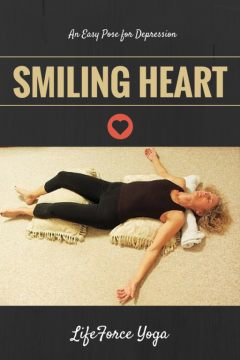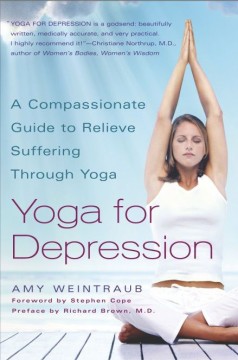
There are specific poses that a beginner can do that can help lift the mood and sustain our positive outlook. Poses should be practiced in the context of a yoga breathing and centering practice. I would recommend a class or an instructional DVD—some type of formal instruction for a beginner. But in general, back-bending poses are more energizing. A simple supported backbend, combined with deep yogic diaphragmatic breathing through the nostrils, extending the exhalation longer than the inhalation can both lift the mood and calm the central nervous system.
Here’s a simple restorative pose recommended in my book Yoga for Depression that meets the lethargy of depression and begins  to build the energy.
to build the energy.
I call this “Smiling Heart Pose.” It requires several props.
- Place two folded blankets, a bolster or a firm cushion under your back, just beneath you shoulder blades. Make sure the lift is comfortable and modify if you need to, using more or less support as feels right for your body.
- Place a rolled blanket underneath your neck so that the back of your head rests comfortably on the floor.
- Place a bolster or cushion under your knees and allow your legs to be a comfortable (usually about hip-width) distance apart.
- Allow your arms to stretch comfortably out at shoulder level, with your palms facing up.
- You may also wish to use an eye pillow in this position. Stay in this position for at least five minutes, practicing the breath described below. To make this posture slightly more stimulating, try lifting your arms over your head on the floor behind you.
Breath: Yogic Three-part Breath (Dirga Pranayama)
Yogic Three-Part Breath can be done in a seated posture but is most easily learned in a lying down position. It is a good breath to practice while in the Smiling Heart Pose above. This pranayama gets breath moving fully through the lungs. It’s a good way to release tensions stored in the body. You may wish to use your hands in the beginning so you can feel the breath moving into and expanding the three separate areas of your lungs. Place both hands on your abdomen, above and below your navel. Relax your belly. As you inhale through the nostrils, feel your lower lungs filling like a balloon, and notice how your belly rises into your hand. Practice breathing fully and deeply into your lower lungs for several breaths. Next, keep one hand on your belly and place the other at the bottom of your rib cage. After filling your lower lungs and inflating your belly, fill your middle lungs so that your ribcage expands and you feel your hand rising on your chest. Practice breathing in this way for several breaths. Next, keep one hand on your belly and move the other hand to your clavicle at the base of your throat. Inhale fully, filling the lower lungs, the middle lungs, then bring the breath into the upper lungs and feel your upper chest expanding into your hand. As you exhale, first deflate your upper lungs, your middle lungs, then your lower lungs, as though you’re pouring the breath out like a glass of water. Once you are comfortable with the breath, bring your arms to the side of your body with the palms face up, or if you are sitting, with your palms face up on your knees.
To make this breathing exercise slightly more stimulating, try holding your breath at the top of the inhalation for no more than four counts. Release the breath for six counts. The slow release is calming and you will stay in balance.
You can stay in this position, breathing Yogic Three-part Breath for at least five minutes but not more than fifteen. If you are in Smiling Heart Pose, come out slowly, using your hands for support, as you roll to your right side and sit up. Sit for a few moments, noticing how you feel in your physical body and your emotional body.
noticing how you feel in your physical body and your emotional body.
To practice with my DVD, you can preview it here.
If you want to find a LifeForce Yoga Practitioner who weaves in yoga-based practices to help you manage your mood, in yoga and psychotherapy settings, visit our practitioner page.